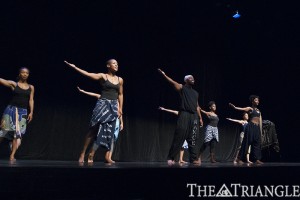Kariamu Welsh and company gave a striking lecture and demonstration Oct. 17 in Drexel’s Mandell Theater on her revolutionary African dance technique, Umfundalai. Welsh, a dance scholar and choreographer, is currently the artistic director of Kariamu & Co.: Traditions, as well as the founding artistic director of the National Dance Company of Zimbabwe in southern Africa. She is a published author and serves as the director of the Institute for African Dance Research and Performance. Her technique, Umfundalai, has been around for more than 40 years and has had a positive influence on Philadelphia’s African dance community.

The night started off with many of Drexel’s dance students gathered around, excitedly discussing what they thought Welsh would include in her lecture and demonstration. As the doors opened and everyone took their seats, drums with empty chairs could be seen from every corner of the room. Welsh would later go on to explain the importance of drums in the African culture and particularly in her technique. Finally, after everyone took their seats and the audience quieted down, Welsh took her place at the podium and began to discuss her life story and travels that shaped the dance technique that was uniquely hers — influenced by modern and contemporary dance but rooted in African rhythms and style elements.
After being discouraged by a previous dance instructor, Welsh created the Umfundalai technique for all body types. She drew specifically from her experiences while living, teaching and performing in Africa.
Soon after discussing her journey as a dancer, teacher and choreographer, Welsh introduced her companions. There were two master teachers, a student on her way to becoming a master teacher, and a few younger students studying dance and other disciplines. Welsh touched on many different facets of the technique, including the spiritual aspect, the respect aspect and the community aspect. All of these qualities are important parts to master when practicing Umfundalai. Soon after, every dancer demonstrated the technique.
The master teacher-in-training performed a solo as the audience was introduced to the drummers and their roles in the performance. Attendees were surprised at the way the dancer moved across the room, so grounded and interactive, in addition to the drummers, paying close attention to her body in space and the particular details of her movement. After the woman’s solo, Welsh introduced more movements of the technique to the audience and requested either the master teachers or the students to show the audience how to perform each move.
The audience watched every movement carefully as the dancers pleasantly interacted with each other, the audience and the drummers, bringing the composition full-circle. Welsh concluded the lecture and demonstration with a question-and-answer session, during which the audience was allowed to discover more about Welsh as a choreographer and the creator of Umfundalai.

